
Security and Aerospace company Lockheed Martin (NYSE: LMT) met Wall Street’s revenue expectations in Q3 CY2025, with sales up 8.8% year on year to $18.61 billion. The company’s outlook for the full year was close to analysts’ estimates with revenue guided to $74.5 billion at the midpoint. Its GAAP profit of $6.95 per share was 9.3% above analysts’ consensus estimates.
Is now the time to buy Lockheed Martin? Find out by accessing our full research report, it’s free for active Edge members.
Lockheed Martin (LMT) Q3 CY2025 Highlights:
- Revenue: $18.61 billion vs analyst estimates of $18.55 billion (8.8% year-on-year growth, in line)
- EPS (GAAP): $6.95 vs analyst estimates of $6.36 (9.3% beat)
- Adjusted EBITDA: $2.92 billion vs analyst estimates of $2.60 billion (15.7% margin, 12.6% beat)
- The company slightly lifted its revenue guidance for the full year to $74.5 billion at the midpoint from $74.25 billion
- EPS (GAAP) guidance for the full year is $22.25 at the midpoint, beating analyst estimates by 1.7%
- Operating Margin: 12.3%, in line with the same quarter last year
- Free Cash Flow Margin: 18%, up from 12.2% in the same quarter last year
- Backlog: $179.1 billion at quarter end, up 8.1% year on year
- Market Capitalization: $118.1 billion
"Based on the effectiveness and reliability of our products and systems, strong demand from Lockheed Martin's customers—both in the United States and among our allies—continues. As a result of this unprecedented demand, we are increasing production capacity significantly across a wide range of our lines of business," said Lockheed Martin Chairman, President, and CEO Jim Taiclet.
Company Overview
Headquartered in Maryland, Famous for the F-35 aircraft, Lockheed Martin (NYSE: LMT) specializes in defense, space, homeland security, and information technology products.
Revenue Growth
A company’s long-term sales performance is one signal of its overall quality. Any business can experience short-term success, but top-performing ones enjoy sustained growth for years. Unfortunately, Lockheed Martin’s 2.7% annualized revenue growth over the last five years was sluggish. This fell short of our benchmarks and is a poor baseline for our analysis.
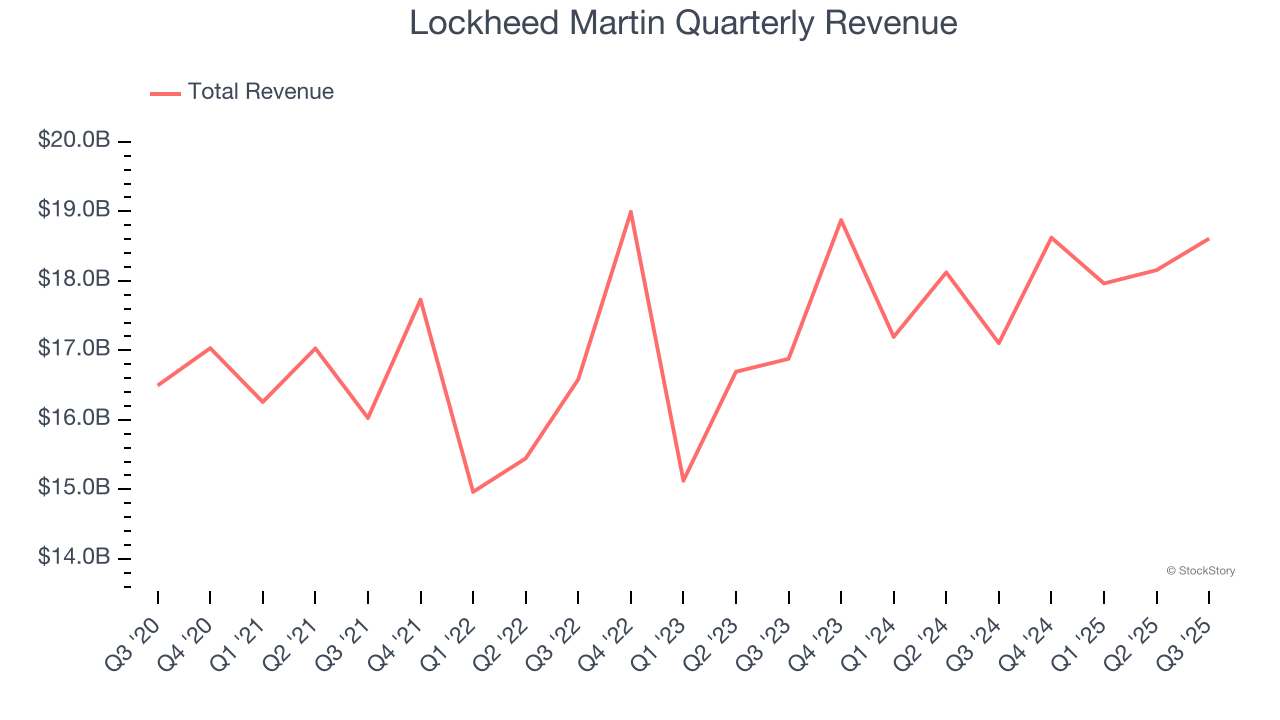
We at StockStory place the most emphasis on long-term growth, but within industrials, a half-decade historical view may miss cycles, industry trends, or a company capitalizing on catalysts such as a new contract win or a successful product line. Lockheed Martin’s annualized revenue growth of 4.1% over the last two years is above its five-year trend, but we were still disappointed by the results. 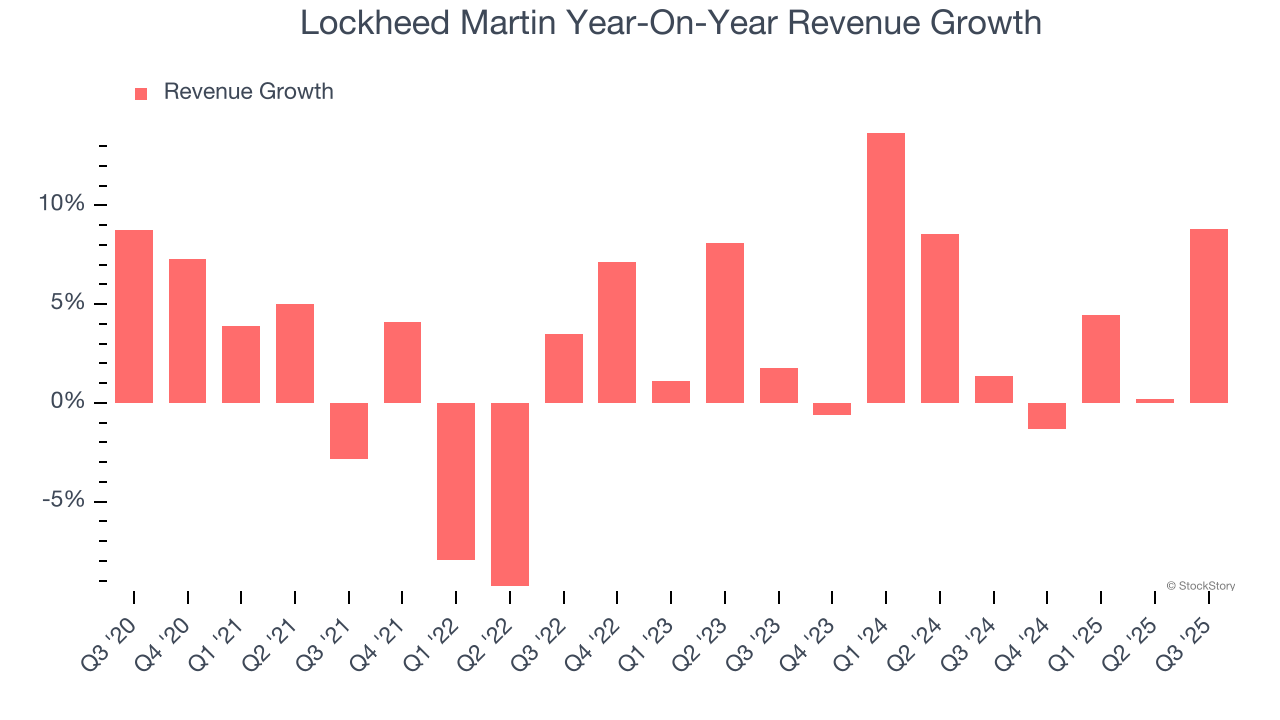
Lockheed Martin also reports its backlog, or the value of its outstanding orders that have not yet been executed or delivered. Lockheed Martin’s backlog reached $179.1 billion in the latest quarter and averaged 6.8% year-on-year growth over the last two years. Because this number is better than its revenue growth, we can see the company accumulated more orders than it could fulfill and deferred revenue to the future. This could imply elevated demand for Lockheed Martin’s products and services but raises concerns about capacity constraints. 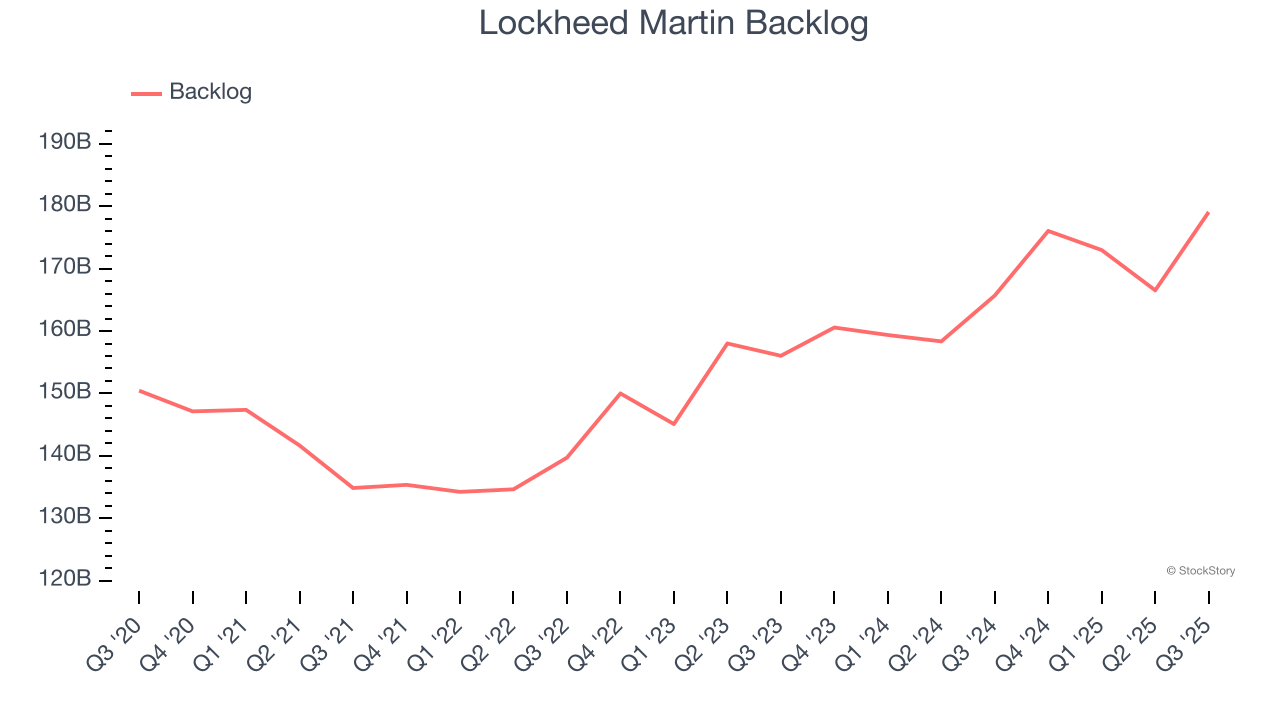
This quarter, Lockheed Martin grew its revenue by 8.8% year on year, and its $18.61 billion of revenue was in line with Wall Street’s estimates.
Looking ahead, sell-side analysts expect revenue to grow 4.3% over the next 12 months, similar to its two-year rate. This projection doesn't excite us and implies its newer products and services will not accelerate its top-line performance yet.
Software is eating the world and there is virtually no industry left that has been untouched by it. That drives increasing demand for tools helping software developers do their jobs, whether it be monitoring critical cloud infrastructure, integrating audio and video functionality, or ensuring smooth content streaming. Click here to access a free report on our 3 favorite stocks to play this generational megatrend.
Operating Margin
Operating margin is an important measure of profitability as it shows the portion of revenue left after accounting for all core expenses – everything from the cost of goods sold to advertising and wages. It’s also useful for comparing profitability across companies with different levels of debt and tax rates because it excludes interest and taxes.
Lockheed Martin has been an efficient company over the last five years. It was one of the more profitable businesses in the industrials sector, boasting an average operating margin of 11.8%.
Looking at the trend in its profitability, Lockheed Martin’s operating margin decreased by 5.2 percentage points over the last five years. This raises questions about the company’s expense base because its revenue growth should have given it leverage on its fixed costs, resulting in better economies of scale and profitability.
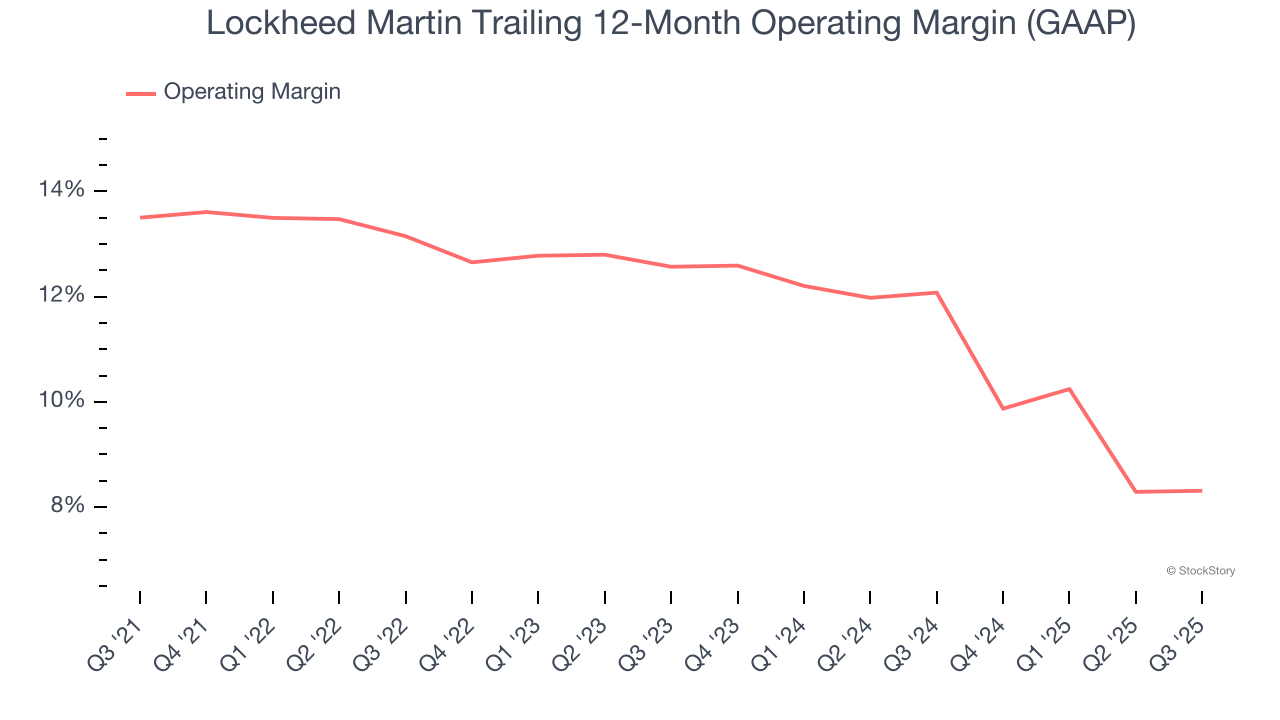
This quarter, Lockheed Martin generated an operating margin profit margin of 12.3%, in line with the same quarter last year. This indicates the company’s overall cost structure has been relatively stable.
Earnings Per Share
Revenue trends explain a company’s historical growth, but the long-term change in earnings per share (EPS) points to the profitability of that growth – for example, a company could inflate its sales through excessive spending on advertising and promotions.
Sadly for Lockheed Martin, its EPS declined by 5.2% annually over the last five years while its revenue grew by 2.7%. This tells us the company became less profitable on a per-share basis as it expanded due to non-fundamental factors such as interest expenses and taxes.
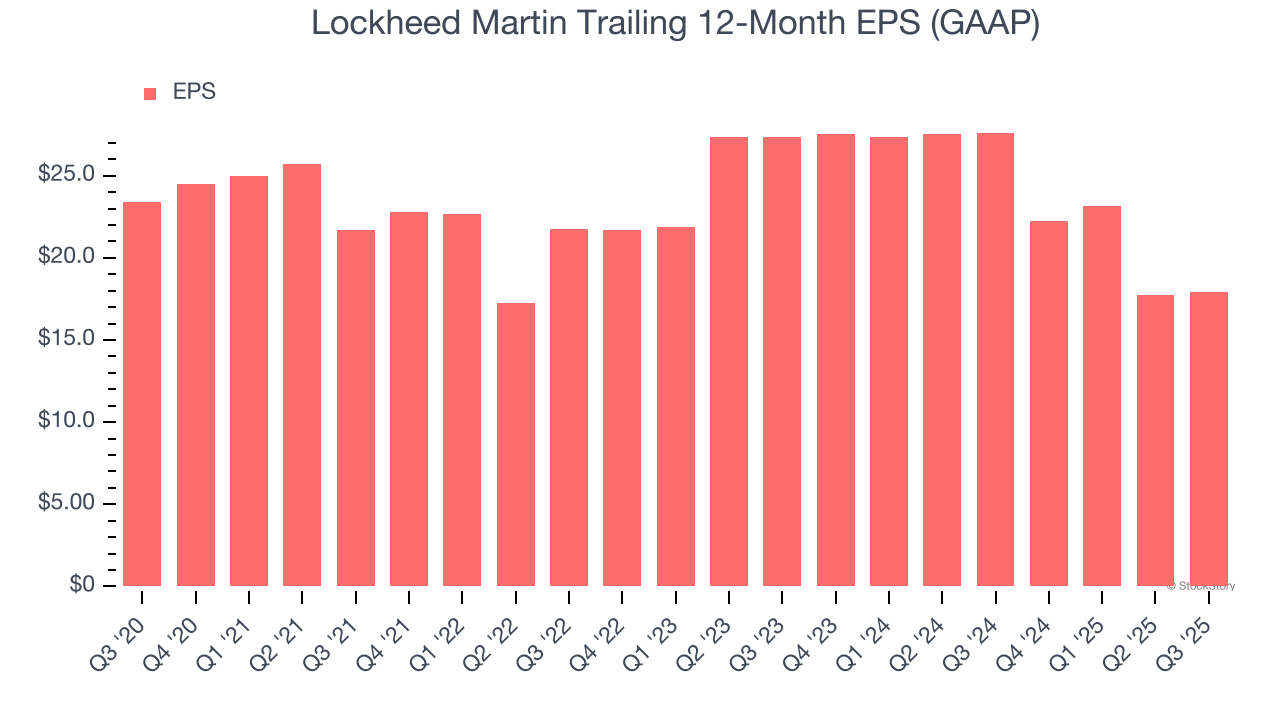
We can take a deeper look into Lockheed Martin’s earnings to better understand the drivers of its performance. As we mentioned earlier, Lockheed Martin’s operating margin was flat this quarter but declined by 5.2 percentage points over the last five years. This was the most relevant factor (aside from the revenue impact) behind its lower earnings; interest expenses and taxes can also affect EPS but don’t tell us as much about a company’s fundamentals.
Like with revenue, we analyze EPS over a shorter period to see if we are missing a change in the business.
For Lockheed Martin, its two-year annual EPS declines of 19.1% show it’s continued to underperform. These results were bad no matter how you slice the data.
In Q3, Lockheed Martin reported EPS of $6.95, up from $6.80 in the same quarter last year. This print beat analysts’ estimates by 9.3%. Over the next 12 months, Wall Street expects Lockheed Martin’s full-year EPS of $17.91 to grow 58.3%.
Key Takeaways from Lockheed Martin’s Q3 Results
We were impressed by how significantly Lockheed Martin blew past analysts’ backlog expectations this quarter. We were also excited its EBITDA outperformed Wall Street’s estimates by a wide margin. Zooming out, we think this was a solid print. The stock traded up 3.1% to $521.75 immediately after reporting.
Indeed, Lockheed Martin had a rock-solid quarterly earnings result, but is this stock a good investment here? When making that decision, it’s important to consider its valuation, business qualities, as well as what has happened in the latest quarter. We cover that in our actionable full research report which you can read here, it’s free for active Edge members.





